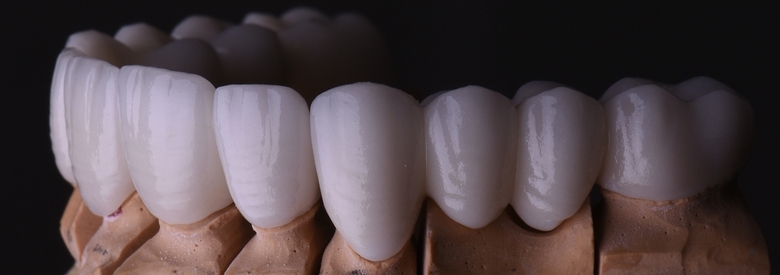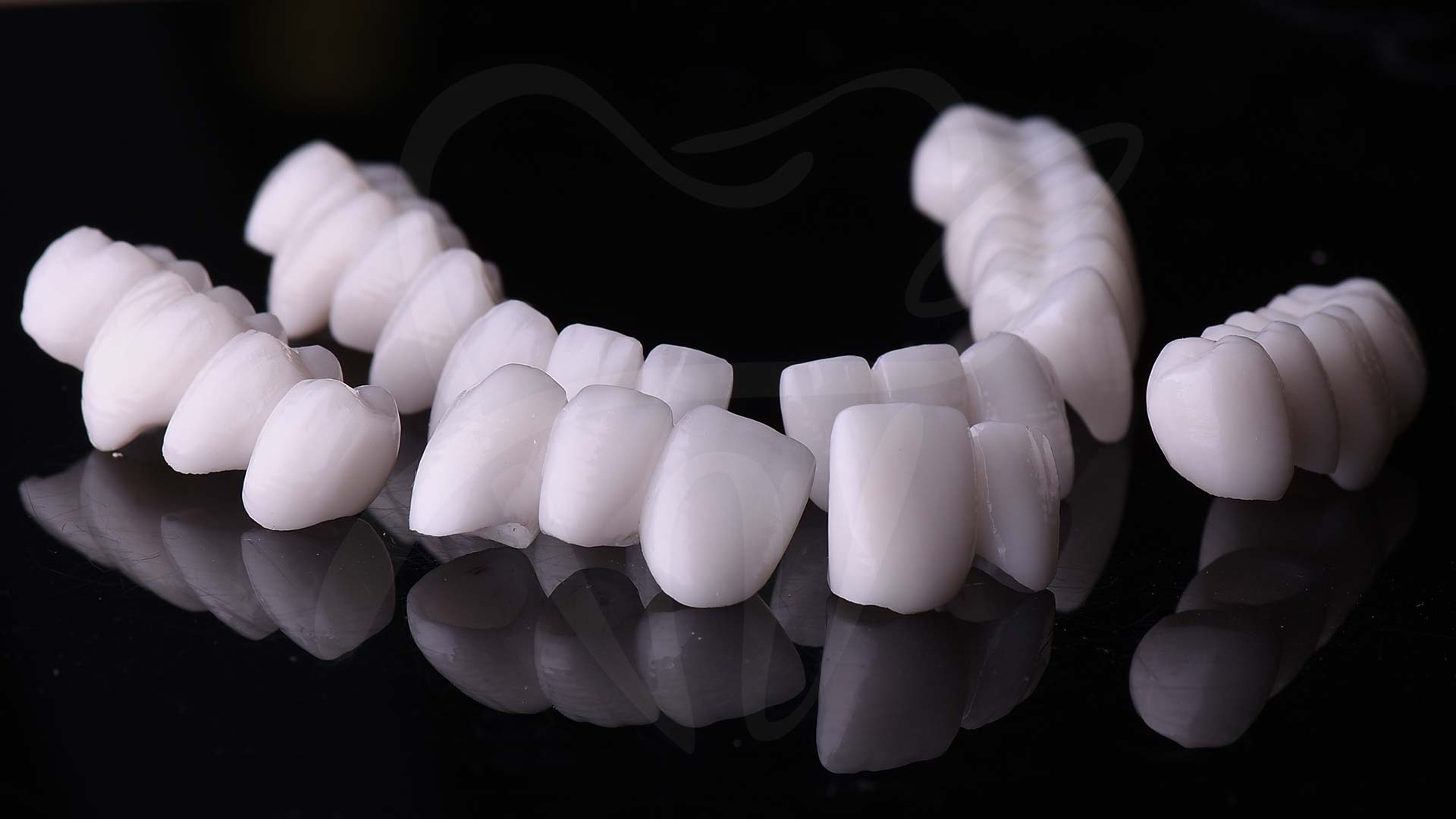
Zubne krunice razlikuju se po materijalima od kojih sačinjene, i, u manjoj meri, po načinu izrade. Sve krunice koje se koriste u savremenoj stomatologiji su keramičke ili metalokeramičke, a razlika je u tome što su keramičke krunice sačinjene samo od keramike, dok metalokeramičke imaju metalno jezgro, koje čini oko 50% zapremine. Razlog za korišćenje dva tipa krunica za istu namenu je u tome što je metal jeftin, jak i lako se spaja sa keramikom, što omogućava izradu krunica sa metalnim jezgrom i keramičkim omotačem po dva puta nižoj ceni u odnosu na keramičke krunice.
Metali koji se koriste u izradi metalo-keramičkih zubnih krunica su hrom, molibden i paladijum. Bezmetalne krunice izrađuju se od cirkonijuma, tačnije od cirkonijum-dioksida (ZrO2), koji spada u grupu keramičkih materijala velike čvrstoće i ne treba ga mešati sa mineralom cirkonom, koji se koristi za bižuteriju. Reč je o oksidu cirkonijuma koji se, osim za veštačke zube, koristi i za veštačke dijamante i druge namene gde je potrebna velika izdržljivost. Moguće je izraditi zubne krunice od legure zlata i titanijuma, što je opcija koja se već gotovo potpuno povukla iz prakse zbog visoke cene.
Krunice se mogu izrađivati ručno, u laboratoriji, ili u CEREC mašini, kakvu poseduje i naša ordinacija. Prednost izrade u laboratoriji je to što je moguće raditi manje i veće mostove od spojenih krunica, dok je prednost CEREC mašine brzina izrade, jer je krunica gotova za manje od 30 minuta, tako da pacijent može doći sa zubom koji ima nedostatak i otići sa krunicom, jer se sve završava tokom jedne posete. Prednost izrade u CEREC mašinama i drugim 3D sistemima leži i u tome što se krunica kreira na osnovu 3D skeniranja, garantujući maksimalnu preciznost.
U ordinaciji Cvejanović najčešće koristimo cirkonijumske krunice kod kojih se keramika nanosi preko cirkonijumske kapice, što obezbeđuje dugotrajnost i odličan izgled. Ponekad koristimo i monolitne krunice od jednog komada cirkonijuma, ali ove krunice su teške i umeju da odzvanjaju prilikom kontakta sa zubom iz suprotne vilice. U našoj zemlji uglavnom nema interesovanja za krunice od presovane keramike, koje se smatraju najlepšim i najsjajnijim tipom krunica, ali su krhke, jer nemaju cirkonijumsku osnovu, a popularne su uglavnom u Americi, gde se ceni vrlo blistav osmeh. Još jedna varijanta je cirkonijum sa keramikom samo sa prednje strane, što je veoma slično rešenje našem rešenju sa keramikom sferično postavljenom oko kapice. Taj tip krunice ne upotrebljavamo iako imamo uslove, jer nema značajnih prednosti.
Iako su metalokeramičke zubne krunice još uvek zastupljene u stomatološkoj praksi, bezmetalne krunice su napravile revoluciju u stomatologiji. Tek sa pojavom bezmetalne keramičke krune dobijena je mogućnost da krunica bude na istom estetskom nivou kao zdrav i pravilno oblikovan prirodan zub.
Kada su estetske razlike između metalnih i bezmetalnih krunica u pitanju suštinska razlika leži u tome što metalokeramičke krunice prelamaju svetlost drugačije od prirodnih zuba i keramičkih krunica, a takođe se razlikuju u nijansi od prirodnih zuba. Ove efekte stvara njihovo sivo metalno jezgro, a efekat je najizraženiji u korenu zuba, gde je metal bliži površini, pa taj deo zuba deluje mračnije. Navedene pojave uglavnom su primetne samo pod jakim svetlom i ne moraju uvek uzeti maha, niti se moraju sve manifestovati.

Krunice od pune keramike
Jednako su važne razlike između metalnih i bezmetalnih krunica na polju biokompatibilnosti i očuvanju zubne supstance. Za razliku od metala, koji može proizvesti alergijske reakcije, promenu boje desni i njihovo povlačenje, bezmetalnu cirkonijumsku krunicu karakteriše potpuno odusutvo reakcija mekog tkiva, odnosno alergijskih reakcija. Kod metalokeramičkih krunica u njenom vratnom delu može se javiti prosijavanje metala i zato se preporučuje podvlačenje ispod desni, kako bi se metlani rub sakrio. Međutim, tu nastaje problem na duge staze, jer će metal postepeno dovesti do daljeg povlačenja desni, tako da će metalni rub krunice verovatno postati vidljiv. Ovaj poslednji argument je najvažniji razlog zašto svim pacijentima koji mogu da ih priušte preporučujemo keramičke krunice.
Vredi pomenuti da keramičke krunice zahtevaju manje uklanjanje zubne supstance. Ako se za metalokeramičku zubnu krunicu mora obrusiti 1.5mm do 2mm zuba, za bezmetalnu zubnu krunicu se uklanja svega 0.5mm do 1mm. Prednost postoji i prilikom izbora boje, jer cirkonijum se boji u bilo koju željenu boju, te ako je izabrana boja budućih keramičkih porcelanskih navlaka A1, onda se i cirkonijum kao podloga krune boji u A1.
Dakle, metalokeramičke krunice imaju dva bitna nedostatka. Prvi je to što je izgled nešto lošiji, budući da nemaju tu stopostotnu belinu i blještavost koju imaju bezmetalne krunice. Iako se sloj metala iza keramike ne vidi, taj metal utične na način na koji se prelama svetlost, zbog čega je belina manje jaka. Izgled je takođe za nijansu lošiji (mada ne kod svih pacijenata) i u delu u kome krunica naleže na desni. U slučaju da se densi povuku posle postavljanja krunica postaće vidljiv sloj metala iz preseka krunice, u vidu tanke sive linije. Kod pacijenata kod kojih ne dođe do povlaćenja neće biti tog problema. Drugi nedostatak blisko je povezan sa povlačenjem desni, a to je nešto slabija biokompatibilnost metalokeramičke krunice. Dok čista keramika ne iritira desni, kod određenog broj pacijenata može doći do postepenog povlačenja desni upravo zbog prisustva metala, a kod kojih pacijenata će se to dogoditi nemoguće je predvideti. U ordinaciji Cvejanović često koristimo i metalokeramičke krunice, iako preferiramo bezmetalne zbog izgleda, posebno kada su u pitanju mlađi pacijenti.
Pacijenti navode da se na mestima gde imaju metalne keramičke krunice teže i duže navikavaju na nove dentalne navlake, da je osećaj drugačiji, i da je boja malo drugačija, dok se na nove bezmetalne krunice navikavaju za jedan ili dva dana. To se može pripisati svojstvima cirkonijuma koji je biokompatibilan za razliku od metala. Metal u metalno-keramičkim zubnim krunicama može proizvesti i pojavu galvanskih struja u ustima i veću iritaciju mekog tkiva tj. desni, a nekad i alergijske rekacije na mekom tkivu. Izrada zubnih metalnih kruna i njihovo planiranje ispod desni dovodi vremenom do povlačenja desni i gubitka kosti, a isto tako i do reakcije mekog tkiva tj. desni na strano telo. Međutim, proces povlačenja desni dešava se i prirodno, tako da se ne može reći da su metalne krunice direktan krivac.
